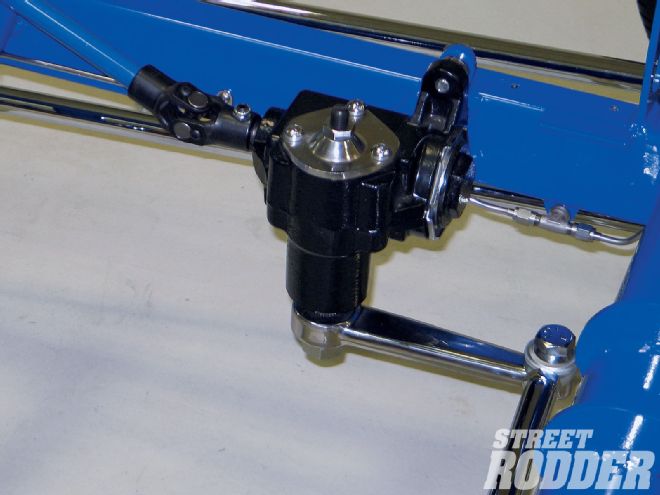
Street rod steering has come a long way. The current traditional street rod movement has precipitated a move to more traditional steering gear. From early Ford, frame-mounted steering boxes to the ever popular through-the-cowl steering-what was old is new again.
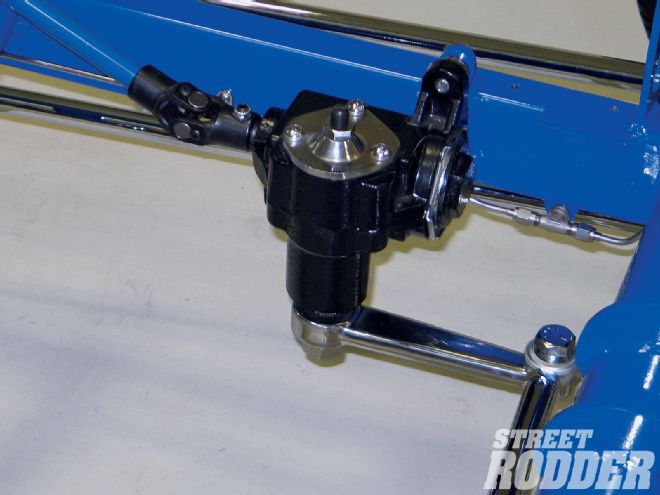
Prior to World War II, and just after World War I, the '37 Ford Gemmer parallel drag link, push/pull, steering box was the norm for steering box swaps. Gemmer Manufacturing of Detroit manufactured the steering boxes for Ford, thus the term Gemmer. Pre-'37 Ford Gemmer steering boxes featured a fixed sector gear, resulting in high resistance and fairly rapid wear. The later Gemmer boxes had a recirculating sector gear, which allowed easier steering, less wear, and a faster steering ratio, and most importantly, they fit neatly onto a Model A or Deuce frame. The preferred Gemmer box was available in Ford, and some other passenger cars through 1948, and in Ford trucks through 1956. This was the hot setup for those postwar hot rodders and dry lakes racers.
Mike Bishop and Vern Tardel discuss all of the ins and outs of installing the Gemmer steering box in their book A-V8 How to Build a Traditional Ford Hot Rod. Tardel also authored a Let Me Help You manual that gives all the information and tricks needed to rebuild and install the early Ford steering box. The manual is available from Vern Tardel Enterprises or Speedway Motors.
The modern era of steering came in the early '60s with the introduction of the recirculating ball and nut gear Corvair steering box. The recirculating ball and nut steering mechanism contains a worm gear inside of the steering box with a threaded hole through it. The worm gear has gear teeth cut into the outside to engage the sector shaft (also called a sector gear), which moves the pitman arm. The rotation of the steering shaft rotates the worm gear inside the steering box and instead of twisting further into the block, the worm gear is fixed so that when it rotates, it moves the sector gear, which transmits the motion through the gear to the Pitman arm.
The worm gear is similar in design to a ball screw; the threads are filled with ball bearings that recirculate through the worm gear as it turns. The balls serve to reduce friction and wear in the gear and reduce slop. Until the advent of rack-and-pinion steering, this was the prevalent steering mechanism in passenger cars and trucks.
Available in both cast iron and aluminum, the Corvair box, especially a polished aluminum model, was popular with the T-bucket brigade. Usually mounted on top of the frame, the input shaft must be reversed in the housing for parallel-drag link steering.
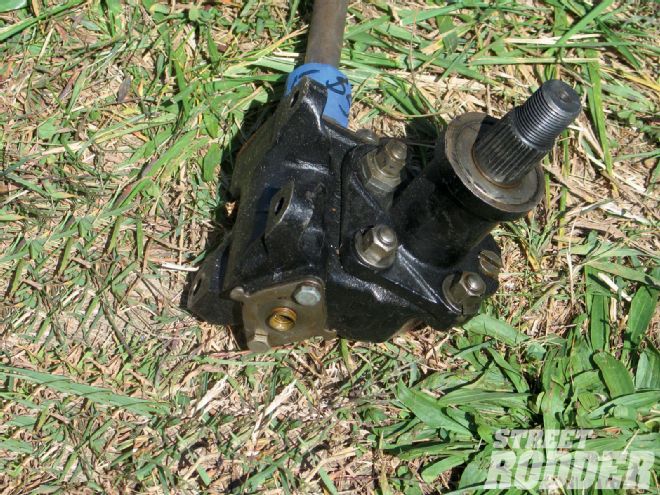 Early Ford Gemmer steering boxes are still available. We located this one at a local swap meet.
Early Ford Gemmer steering boxes are still available. We located this one at a local swap meet.
In order to reverse the Corvair box you must first disassemble the box. After disassembly, drill a 3/16 pilot hole in the center of the pot metal worm screw adjusting nut; follow that with a 7/8-inch hole. Tap a new shaft lip seal in the newly drilled hole. Remove the shaft seal and install a 7/8-inch freeze plug in the hole where the steering shaft formally exited. Both ends of the unit already have identical bearing races so that isn't an issue. Then, reassemble the box with the steering shaft coming out of the hole you drilled in the adjusting nut. California Custom Roadsters (CCR) has a kit containing the required bearings, seals, and instructions for reversing a Corvair box.
If that is too much work or you don't have a Corvair box to modify, CCR, Flaming River, and Speedway Motors, all offer a steel, reversed Corvair-style steering box. CCR also offers a remanufactured, polished aluminum Corvair box.
In the mid-'60s Ford introduced the recirculating ball and nut gear in the first Mustangs. It was truly a reliable manual steering box and it was designed to work with the 2,500- to 2,700-pound Ford Mustangs. A much better match for a street rod than the Corvair, and as an added bonus the Mustang box did not need to be reversed. The Mustang box was mounted to a plate on the frame, near the firewall and operated in a push pull fashion, with the Pitman arm located at the 12 o'clock position. Speedway Motors, and others, offer a weld-on plate to mount the Mustang box. Some do not consider the Mustang box traditional, but it has been around for over 40 years, so where does tradition begin?
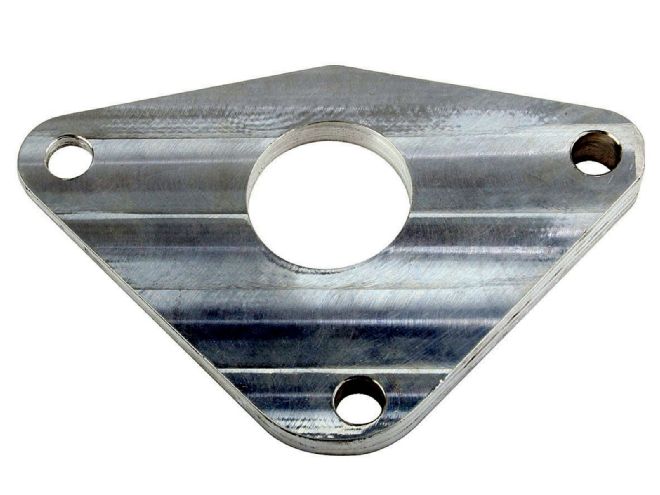 This tapered shim is available from Speedway Motors, or Vern Tardel Enterprises. The shim allows the F-100 Ford pickup truck Gemmer steering box to be used in tapered passenger car frames without modification to the steering box flange.
This tapered shim is available from Speedway Motors, or Vern Tardel Enterprises. The shim allows the F-100 Ford pickup truck Gemmer steering box to be used in tapered passenger car frames without modification to the steering box flange.
In 1971, GM introduced the Chevrolet Vega. The Vega steering box was a recirculating ball and nut design, similar to the Mustang. Street rodders soon gravitated to the Vega as the steering box of choice, and since that time the Vega steering box has gone on to become the mainstay for street rod steering. Like the Mustang box, the Vega box was mounted to a plate on the frame near the firewall and the Pitman arm was located at the 12 o'clock position when used in a push/pull, drag link, design.
Soon rodders discovered that the Vega box could be used in a cross steer mode in a street rod. While not everyone agreed, the cross steer system was considered superior to the parallel drag link system in that it reduced bumpsteer. Soon street rod parts manufacturers were offering bracket kits to mount the Vega box in almost any frame in a cross-steer style.
The Saginaw 525 manual steering box is a larger version of the popular Vega box and is more suited for cars over 3,000 pounds, like fat-fendered hot rods. The Saginaw 525 has the standard three-bolt mounting pattern found on the Vega and is interchangeable in the mounting, however, the Saginaw 525 output shaft splines are larger than the Vega.
Mustang, Vega, and Saginaw 525 steering boxes are available from Borgeson, Flaming River, Speedway Motors, and others. A high tech, billet aluminum version of the Vega-style box is available from Borgeson. The newly manufactured and remanufactured steering boxes available today are often better than the original parts, in that they have larger bearings and utilize modern, close tolerance, machining techniques. Mounting bracket kits are also available from these and other manufacturers.
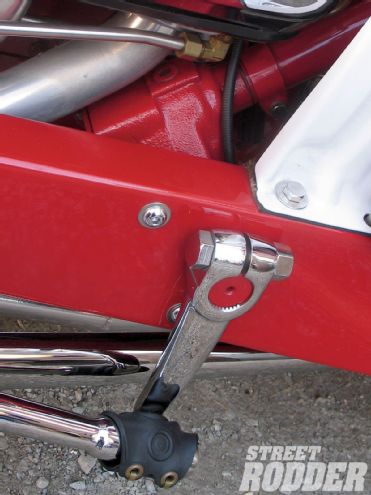 For tradition you can't beat an early Ford steering box mounted to '32 'rails. Check out the neat tie-rod end .protector.
For tradition you can't beat an early Ford steering box mounted to '32 'rails. Check out the neat tie-rod end .protector.
Although not considered traditional, the Mustang II independent front suspension has a large presence in the world of street rods, both in its stock version and the numerous aftermarket designs based on the Mustang II. The obvious steering choice for the Mustang II suspension was the Mustang II rack-and-pinion steering setup. The popularity of the Mustang II front suspension conversion in street rods has led to a number of aftermarket rack-and-pinion steering boxes for the Mustang II.
One of the latest steering boxes for a street rod with a transverse leaf spring, solid axle, front suspension, and a cross steer setup is the Unisteer Performance rack-and-pinion steering box. A direct replacement for a Vega-style steering box in a cross steer system, the Unisteer rack-and-pinion steering box gives you the tightness and feel of the road offered by a rack-and-pinion system and the looks of the traditional front suspension.
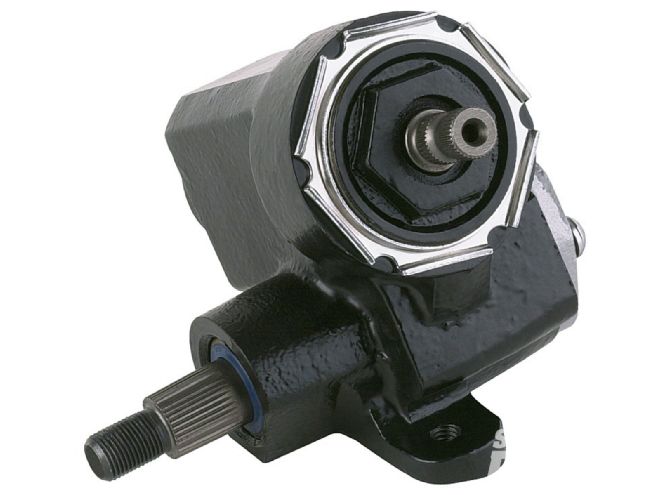 This is the steel version of the reversed Corvair Steering box available from Flaming River and Speedway Motors. The input shaft now enters the adjusting nut. The aluminum version is scarce, but California Custom Roadsters manages to keep some in stock.
This is the steel version of the reversed Corvair Steering box available from Flaming River and Speedway Motors. The input shaft now enters the adjusting nut. The aluminum version is scarce, but California Custom Roadsters manages to keep some in stock.
With the traditional movement in street rods, what was old is new again. We are seeing more frame-mounted early Ford and F-100 Gemmer steering boxes, as well as Mustang, and reversed Corvair and Vega boxes. Obviously parallel drag link, push/pull steering is far more traditional than the cross steer counter part.
Speaking of what is old is new again, through-the-cowl steering has once again become a popular steering style. The cool look of the pitman arm hanging out the side of the cowl, connected to a long drag link that, in turn, connects to a hoop-style steering arm actually goes back to early race car steering. As a matter of fact, today's Midget and Sprint car racers continue to use this style of steering.
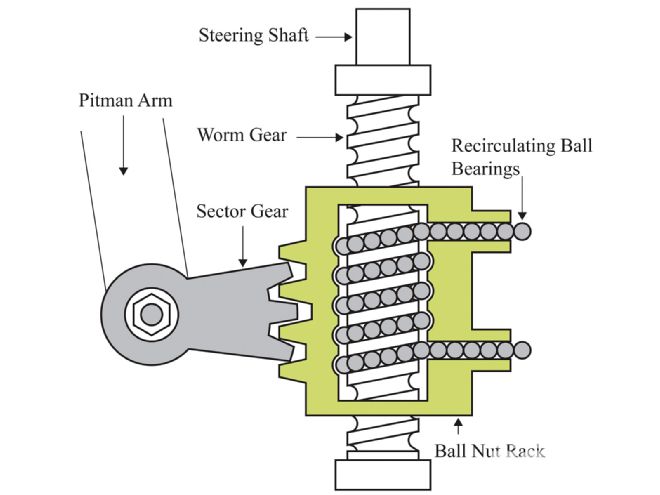 The recirculating ball and nut steering box design allowed more precise steering action, less effort to operate, less slop, and less wear.
The recirculating ball and nut steering box design allowed more precise steering action, less effort to operate, less slop, and less wear.
Early on the preferred steering box for this steering style was the Franklin steering box from Series 9 ('16-21) and Series 10 ('22-24) Franklin automobiles. The Chrisman Brother's famous number 25 dragster, one of the first purpose-built drag cars, utilized a Franklin steering box in a through-the-cowl steering setup, as did many early Midget, Sprint, and Indy cars. As the Franklin unit became scarcer, the Ross center steering unit, found in a variety of forklift trucks, became the steering box of choice. The '48-52 Crosleys also utilized a Ross steering box, but it was not as beefy as the forklift models. Eventually various manufacturers, like Jones, Halibrand, Norden, Schroeder, and others reacted to the racers needs and began manufacturing through-the-cowl, or center steering-style steering boxes specifically for oval track racing applications.
The popular Vega steering box, and the even better aftermarket Vega-styled steering boxes, offered by the aftermarket steering gear manufacturers, when reversed and with extension shafts can be utilized for through-the-cowl steering, as can the reversed Corvair box. The process to reverse a Vega box is the same as the Corvair box.
Gas Alley Street Rod Parts manufactures a cowl steering kit that is designed to work with a reversed Corvair steering box. The kit consists of an output shaft adapter that is splined to match the Corvair box, an extension shaft that bolts to the adapter, a machined end piece for the shaft, a straight-cut Pitman arm, and instructions. Everything required, except the steering box, to create a neat and simple through-the-cowl steering setup. CLASSIC TRUCKS Editor Jim Rizzo recently installed this kit in one of his builds. (SR August '09 issue.)
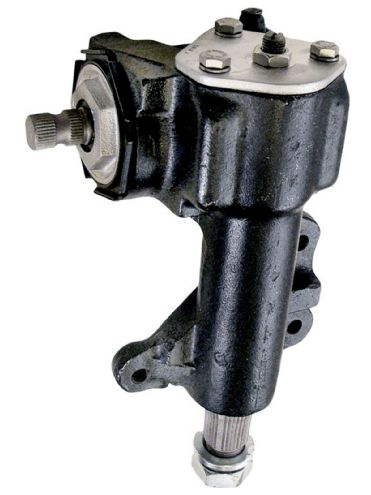 The '65-67 Ford Mustang steering box continues to be a popular steering box when frame-mounted in a push/pull, drag link configuration.
The '65-67 Ford Mustang steering box continues to be a popular steering box when frame-mounted in a push/pull, drag link configuration.
Borgeson can provide a reversed '55-57 Chevrolet steering box that is suitable for through-the-cowl steering. The steering box comes with a short splined input shaft, not the entire column as found on the original Tri-Five steering box. The design of the original Tri-Five steering box offers a longer sector shaft (cross shaft), making it more adaptable to through-the-cowl steering. This is not a Borgeson catalog item, but they will modify one for you if you give them a call.
A recent trend in through-the-cowl steering is the Mopar steering box. Reversing is not required and the aluminum-cased version looks good as is, or looks especially good when polished. Pretty much any steering box from Plymouth/Dodge manufactured from the mid-'60s to '79 will work. Like the Vega, Corvair, and others, the Mopar box will require modifications to extend the sector shaft through the cowl. A steel version of the Mopar box is available from Flaming River and Speedway Motors, while Borgeson offers a remanufactured, OEM, aluminum Mopar box.
In order to determine if your steering box is set up correctly for through-the-cowl steering, set the Pitman arm at 6 o'clock and turn the input shaft clockwise, the output shaft end must turn counterclockwise.
For pure simplicity, race car style, and the real deal, the Schroeder Racing Products worm and gear steering box has become the standard. Developed by Gordon Schroeder in the early '50s, the aluminum steering box is still being manufactured by the same company, now handled by Gordon's oldest son, Gary. One of Gordon's first hot rod steering boxes was manufactured for Doan Spencer's '32 Ford roadster. The original 8:1 steering ratio was great for Sprint and Midget race cars, however, it took a lot of arm strength to make them work in a street rod. But now you can have the cool retro look of a Schroeder steering box with a steering ratio you can live with.
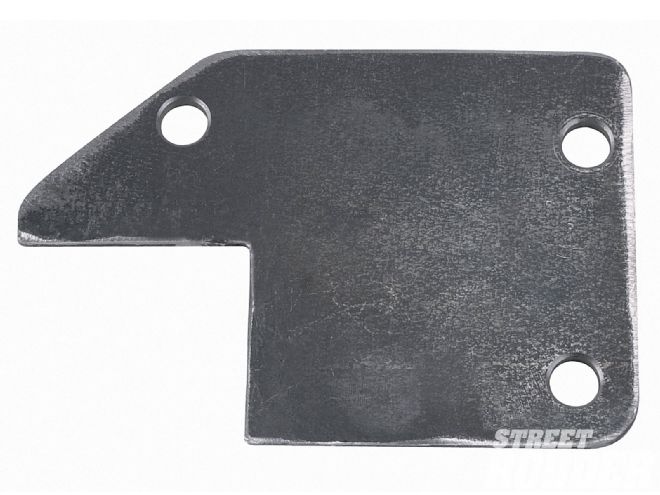 Mounting plates for a number of various steering boxes are available from Speedway Motors and others.
Mounting plates for a number of various steering boxes are available from Speedway Motors and others.
Seeing the popularity of the Schroeder box in street rods, Schroeder Racing Products has developed an integral reducer to change the 8:1 steering assembly to a very manageable 16:1. The unit replaces the existing column shaft and mounts directly to the main housing. The reducer houses an internal gear set that doubles the existing gear ratio. Sort of like an overdrive for your steering box. The unit can be ordered as part of a complete steering box assembly or as a separate part to update existing or swap meet found Schroeder Sprint/Midget four-bolt housings.
The original Schroeder steering box had an integral 9-inch-long steering shaft, suitable for race car applications, but not always adaptable to street rods. Column lengths longer than 9 inches are now possible with a new splined coupling. The shaft can also be easily adapted to an enclosed column, if you prefer that look.
The Schroeder box also can be ordered with various column shaft lengths, sector shaft lengths from 8-15 inches, an extended end for additional chassis clearance, gearbox mounted above or below the sector shaft, and mounting configurations to fit your needs. This eliminates extension shafts, welded adapters, and pinned couplers.
Schroeder also has a full line of pitman arms designed to provide various steering ratios. Gary says that the pitman arm length is the most important selection made in a through-the-cowl steering setup. The longer the pitman arm the harder the vehicle will be to steer, and it will also be very sensitive to bumps, uneven roadways, and more. The shorter the pitman arm, the easier the vehicle will be to steer, but it will be less sensitive, thus, the importance of selecting the correct Pitman arm length.
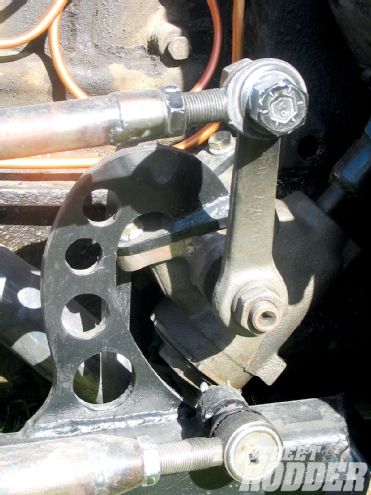 Mounting, depending on the steering box of choice, can be through-the-frame, mounted to one of many available mounting plates welded to the frame, or in this case a more interesting approach to mounting the steering box.
Mounting, depending on the steering box of choice, can be through-the-frame, mounted to one of many available mounting plates welded to the frame, or in this case a more interesting approach to mounting the steering box.
Obviously there were, and there are other steering boxes, including rack-and-pinion styles, that have been, and are adaptable to street rods, but this about covers the most popular forms of street rod steering. There are a number of how-to books, past articles in SR, and websites that can supply an abundance of information on selecting, mounting, and modifying various steering systems to work in your street rod.
Keep in mind that the integrity of any steering system is important to both you and your passengers, as well as those sharing the highways with you. Use Grade 8 fasteners. If you must weld, use the proper materials and welding techniques. If you are not a certified welder, look one up.
Push/pull drag link, cross steer, rack-and-pinion and through-the-cowl steering, when designed correctly and installed properly, will all allow you to turn your wheels and get your street rod headed in the right direction. The look you desire will more than likely dictate your steering choice. And let's face it, it is all about "the look."